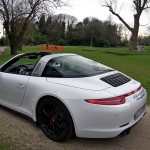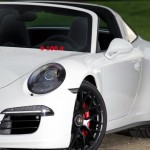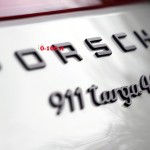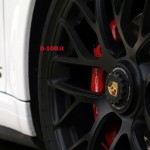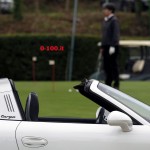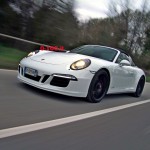TEST DRIVE: Porsche 911 Targa 4 GTS MK1
L’ARCO DI TRIONFO. TROPPO… “FACILE” ACQUISTARE UNA 911 COUPE’ O UNA CABRIO. IL PORSCHISTA CHE AMA DEFINIRSI TALE SCEGLIE SICURAMENTE UNA 911 TARGA. FINALMENTE, DOPO LE POCO EVOCATIVE 993, 996 E 997, QUESTO IMPORTANTE MODELLO TORNA ALLE ORIGINI (E CON IL SUO MERAVIGLIOSO ARCO ROLLBAR IN ACCIAIO) CON LA 991. MA FACENDO UN PASSO AVANTI: IL MOVIMENTO DI RIMOZIONE DEL TETTO E’, ORA, COMPLETAMENTE AUTOMATICO. PROVIAMO LA 4 GTS, ANCORA CON MOTORE ASPIRATO (3.8 LITRI, 430 CAVALLI).
Le strade del mondo hanno accolto da ormai molti mesi la nuova Porsche 991 Carrera MK2, il modello che segna una delle rivoluzioni più importanti nella storia della Elfer: addio al motore aspirato, benvenuto motore turbo (un boxer 6 cilindri di 3 litri con due turbocompressori sostituisce il boxer 6 cilindri aspirato di 3,8 litri). Per tuffarci nella tradizione anche se già immersi nella modernità della 911, abbiamo scelto il nostro modo: una 911 Targa. E crediamo che questo modello sarà uno dei prossimi protagonisti del mercato da collezione tra le Carrera.
IL CONCETTO
911, Targa, 4, GTS: in una sola denominazione l’esemplare in prova per 0-100 racchiude quattro personalità. La 991 Targa è una 911 complessa, frutto di oltre 50 anni di evoluzione tecnologica ma rispettosa, quasi al 100% del dettato originale (a voler essere pedanti: ci voleva il lunotto “morbido” come sulla prima del ’66!): “911”, il modello Porsche per eccellenza, “Targa” la versione di carrozzeria per gli intenditori, 4, la trazione integrale che ha le sue radici nei rally africani e nella favolosa 959, GTS, il marchio a fuoco della sportività sul tema della Carrera. La nostra 911 esibisce l’ultima evoluzione del boxer 6 cilindri aspirato, lontanissimo parente dell’unità 6 cilindri 2 litri raffreddata ad aria che nacque nel ’63. Il motore aspirato è una filosofia, è come il tuo colore preferito, come il tuo cocktail preferito, come il tuo brandy preferito, come il tuo quadro preferito: non lo spieghi, lo senti tuo! Il motore Turbo ha un altro funzionamento, diverso. Un aspirato ti rapisce nel suo allungo progressivo, non “strappa”, ti coccola.
Il boxer 6 cilindri, in questa configurazione, raggiunge 430 Cv a 7.500 giri e produce una forza di 440 Nm a 5.750 giri. E’ il frutto di un kit di potenziamento da 30 Cv rispetto al motore “S” standard, ottenuti con un diverso impianto di aspirazione e una nuova distribuzione (era in listino a oltre 14.000 euro sulle versioni “S” della 911 Carrera).
DESIGN
Bianca con cerchi da 20″ RS monodado in tinta nera: sotto la linea di cintura ti toglie il fiato per la sua prorompente forma burrosa; la 911 è un’esplosione di rotondità, che la tinta ammantata esalta ancora di più. Sopra, quell’arco metallico con la scritta Targa assurge senza mezzi termini al rango di scultura. Targa la rende ancora più 911 e ti identifica ancora di più come Cavaliere del Sacro ordine della Neun Elfer.
E’ il frontale la parte forse meno riuscita: ci sono ben 5 prese d’aria, accatastate l’una fianco all’altra come su un coupé giapponese. Mentre gli occhi della 911 ti ipnotizzano, nella parte inferiore sembra che i designer siano andati alla ricerca spasmodica di qualcosa di speciale ma il risultato sia, al contrario, alquanto anonimo. La coda, invece, è un capolavoro di coerenza: bella, sinuosa ma, soprattutto, coerente con la forma della prima 911. Osservando una Ferrari 488 GTB non riesci a vedere immediatamente una 308 GTB del ’75
Anche l’abitacolo non ti tradisce: “tedesco”, “Porsche”, nulla più. Bellissimo il volante a tre razze dal design semplice e funzionale, intrigante la strumentazione a 5 elementi con il contagiri rigorosamente al centro. Il componente certamente più originale è il grande tunnel centrale ad andamento discendente, un elemento d’arredo senza dubbio caratterizzante l’atmosfera. I sedili sono comodi e hanno una seduta rigida, una sensazione piacevole per una sportiva da 430 cavalli.
MECCANICA
La 991 Targa 4 GTS celebra 50 anni di 911 Targa. Entrata in listino a marzo 2015 al prezzo di oltre 140.000 euro, la GTS porta ha portato su questa variante di carrozzeria il trattamento “sportivo” già disponibile per 991 Carrera Coupé e Cabrio. Rispetto a una 911 con trazione posteriore ha carreggiate allargate di 44 mm, ruote da 20″ con dado centrale, ammortizzatori a controllo elettronico con PASM, specchietti specifici, fari bi-xeno con sistema Porsche Dynamic Light System, pack Sport Chrono, sedili Sport Plus, pneumatici surdimensionati da 245/35 ZR 20 davanti e 305/30 ZR 20 al posteriore.
AL VOLANTE
L’appagante giro di chiave con la mano sinistra produce un concerto di 6 pistoni in totale armonia con la macchina. E’ come se il sound fosse lui stesso a plasmare i volumi di quest’iconico oggetto con il timbro dei suoi decibel.
La Carrera più sportiva ti comunica subito alcune sensazioni determinanti: volante verticale, sedile infossato nella parte posteriore e schienale perfettamente disegnato sul tuo contorno-schiena. Alle basse velocità lo sterzo ha un azionamento duro e il gas, con l’acceleratore incernierato sul pavimento, produce un’erogazione corposa ma molto lineare. L’impressione è che la 911 di oggi voglia soprattutto dare prova di una eccellente maturità: è una Neun Elfer al midollo ma è il risultato di 50 anni di evoluzione, con tutte le ovvie conseguenze rispetto a un 911 S 2.4 del ’72 o una Carrera 3.2 dell’86. Il cambio PDK ha un’elettronica ormai intelligente oltre ogni aspettativa: le cambiate arrivano sempre quando le immagineresti e, naturalmente, i passaggi marcia fino alla settima sono impercettibili.
Passando in Sport Plus la gestione della trasmissione diventa molto più “spinta” e la curva di coppia si fa più ripida. Ciononostante la 911 4 GTS conserva un’erogazione improntata alla progressione. Non è un motore “violento” e studiato per squarciare l’asfalto ma, con un equilibrio assolutamente straordinario, la 911 ti comunica ancora una volta come in mezzo secolo di vita sia riuscita a mantenere e indirizzare alla perfezione un layout assolutamente sfavorevole! Il motore a sbalzo sul posteriore – infatti – si fa sentire, specialmente nelle curve veloci affrontate a velocità elevate: le asperità del terreno restituiscono sulle braccia l’emozionante consapevolezza che il posteriore della 911 guida il resto della vettura. Il peso, del resto, non è poco: su questa versione siamo a quasi 1600 chili a vuoto, distribuiti soprattutto in coda. Ciononostante la 991 di oggi è una GT a prova di errore. Parliamo pur sempre di un missile capace di appena 4″1 sullo 0-100 e con la “cara e vecchia” indole da tutto dietro ad allargare la coda nelle forti accelerazioni: il che resta – di fatto – quasi impossibile. La sospensione posteriore multibraccio assicura il 100% del battistrada al contatto con l’asfalto e le ruote posteriori da 305 producono una tenuta laterale quasi surreale.
Un grandioso miglioramento, infine, la 911 l’ha compiuto sull’aerodinamica alle alte velocità. Quella “sinistra” sensazione di galleggiamento dell’anteriore è un pallido ricordo del proverbiale atteggiamento da zoticona delle 911 “di vecchia scuola”. La 911 – per carità – continua a esserlo, ma lo spirito innovativo della Casa Madre l’ha trasformata in una GT futuristica.
IN CONCLUSIONE
Con l’avvento della 991 Carrera MK2 a motore turbo e con la spaventosa speculazione in atto sulle 911, la Targa 4 GTS della famiglia “991 MK1” è un boccone imperdibile: è una 911 aspirata 300 orari, con la stessa cavalleria di una 993 Turbo (1995) con Power Kit ma un’anima seria, razionale. Produce ben 430 Cv ma te li mette a disposizione con “intelligenza”. Non è una 911 per rozzi capitani di ventura ma una Elfer per duchi e ambasciatori: forte ma impeccabile, generosa ma inflessibile. E con un tocco di pulsante si trasforma in pochi secondi nell’irresistibile Targa che abbiamo imparato a conoscere.
[vc_tta_tabs active_section=”1″ title=”Scheda Prodotto”]
[vc_tta_section title=”Album fotografico” tab_id=”1aTBnwOpost”]
[/vc_tta_section]
[vc_tta_section title=”Dati tecnici” tab_id=”2aTBnwOpost”]
| MOTORE | Posteriore, longitudinale, a sbalzo, 6 cilindri boxer raffreddato ad acqua |
| cilindrata | 3.800 cc |
| Alimentazione | Iniezione diretta di benzina |
| Distribuzione | Bialbero a camme in testa, 4 valvole per cilindro, fasatura variabile |
| Potenza | 430 Cv a 7.500 giri |
| Coppia | 440 Nm a 5.750 giri |
| CORPO VETTURA | |
| Sospensioni ant. | McPherson, ammortizzatori a controllo elettronico PASM |
| Sospensioni post. | Multilink, ammortizzatori a controllo elettronico PASM |
| Sterzo | Cremagliera con servosterzo |
| Pneumatici | ant. 245/35 ZR 20, post. 305/30 ZR 20 |
| Impianto freni | 4 dischi ABS, ESP |
| TRASMISSIONE | |
| Trazione | Integrale permanente (PTM) |
| Cambio | doppia frizione PDK con 7 marce |
| DIMENSIONI E PESI | |
| Dimensioni | Lungh. 4.509 mm, largh. 1.852, alt. 1.291 mm, passo 2.450 mm |
| Volume baule | 125 litri |
| Peso a secco | 1.580 kg |
| Serbatoio | 68 litri |
| PRESTAZIONI | |
| 0-100 km/h | 4″3 |
| Velocità max. | 301 km/h |
| Consumo | urbano 13,9 l/100 km, extraurbano 7,7 l/100 km, medio 10 l/100 km. |
| Emissioni | 237 g/km di Co2 |
[/vc_tta_section]
[vc_tta_section title=”Consumi Rilevati” tab_id=”4aTBnwOpost”]
Percorrenza complessiva: 736 chilometri
Consumo medio (135 km/h): 10,9 l/100 km
Consumo medio (130 km/h): 9,1 l/100 km
Consumo medio (urbano): 17,2 l/100 km
Consumo medio complessivo: 12 l/100 km
[/vc_tta_section]
[/vc_tta_tabs][:en]
THE TRIUMPHAL ARCH. TOO… “EASY” TO BUY A 911 COUPE OR A CONVERTIBLE. THE PORSCHE LOVERS WILL DEFINITELY CHOOSE A 911 TARGA. FINALLY, AFTER THE LITTLE EVOCATIVE 993, 996 AND 997, THAT IMPORTANT MODEL COMES BACK TO ITS ORIGINS WITH THE 991 (AND WITH ITS WONDERFUL STEEL ROLLBAR ARCH). HOWEVER STEPPING FORWARD: THE ROOF REMOVAL MOVEMENT IS TODAY FULLY AUTOMATIC. WE WILL TEST THE 4 GTS, STILL EQUIPPED WITH ASPIRATED ENGINE (3.8 LITRES, 430 HP).
The streets of the world have been welcoming for many months the new Porsche 991 Carrera MK2, the model marking one of the most important revolutions in the Elfer history: goodbye aspirated engine, welcome turbo engine (a 3-litre 6-cylinder boxer with two turbochargers replaces the aspirated 3.8 litres 6-cylinder boxer). To dive into the tradition though already immersed in the modernity of the 911, we have chosen our way: the 911 Targa. We believe that model will be one of the next protagonists of the Carrera collection market.
THE CONCEPT
911, Targa, 4, GTS: in a single denomination, the test specimen for 0-100 encloses four personalities. The 991 Targa is a complex 911, the result of over 50 years of technological evolution, but respectful, almost 100% of the original requirement (to be pedant: it needed a “soft” rear window as for the one of 1966!): the “911”, the Porsche model par excellence, the “Targa”, the body version for connoisseurs, the 4, the four-wheel drive which has its roots in African rallys and in the fabulous 959, the GTS, the sports brand on the Carrera theme. Our 911 shows the latest evolution of the aspirated 6-cylinder boxer, very far relative of the air cooled 2-litres 6-cylinder unit which was born in 1963. The aspirated engine is a philosophy, it is like your favourite colour, your favourite cocktail, your favourite brandy, your favourite picture: you cannot explain it, you feel it is yours! The Turbo engine has a different working. The aspirated engine will fascinate you with its progressive extension, it will not tear, it will cuddle you.
The 6 cylinder boxer, in that configuration, reaches 430 hp at 7.500 rpm and produces 440 Nm at 5.750 rpm. That is the result of a 30 hp expansion kit compared to the standard “S” engine, obtained with a different aspiration system and a new distribution (its list cost was over 14.000 euros for the “S” versions of the 911 Carrera).
DESIGN
White body with 20” RS single nut black rims: below the belt line, it will take your breath away for its overflowing soft shape; the 911 is a roundedness explosion further exalted by its covered shade. Above, that metal arch with the name Targa looks like a real sculpture. Targa makes it even more 911 and identifies you even more as Knight of Sacred Order of the Neun Elfer.
Perhaps the front is the least successful part: there are 5 air vents stacked side by side as well as for a Japanese coupe. As the 911 eyes hypnotize you, at the bottom it seems that the designers have searched for something special but the result is somewhat anonymous. The tail, however, is a masterpiece of consistency: wonderful, sinuous but, above all, consistent with the first 911 shape. Looking at a Ferrari 488 GTB you can not immediately see a 308 GTB 1975
Even the cockpit will not betray you: “German”, “Porsche”, nothing more. The three-spoke steering wheel is wonderful with a simple and functional design, while the 5-piece dashboard is intriguing with the tachometer in central position. The most original component is the large central descending tunnel, an indispensable element for the atmosphere. The seats are comfortable and rigid, a pleasant feeling for a 430 hp sports car.
ENGINEERING
The 991 Targa 4 GTS celebrates 50 years of 911 Targa. Added to the price list in March 2015 at over 140.000 euros, the GTS has brought on that body variation the “sporty” treatment already available for the 991 Carrera Coupé and Cabrio. Compared to a rear wheel drive 911, it has wider than 44 mm wheel tracks, 20” wheels with central nut, electronic control damper with PASM, special mirrors, bi-xenon headlights with Porsche Dynamic Light System, Sport Chrono package, Sport Plus seats, oversized tyres 245/35 ZR 20 front and 305/30 ZR 20 rear.
DRIVING
When your left hand turns the key, you feel satisfied by a 6-pistone concert in complete harmony with the car. It is as if the sound itself were shaping the volumes of that iconic object with the tone of its decibels.
The more sports Carrera immediately gives you some definite feelings: vertical steering wheel, seat sunken in the back and backrest perfectly designed on your back profile. At low speeds the steering wheel has a hard start up and the gas, with the accelerator hinged on the floor, produces a full, but very linear distribution. Our impression is that today’s 911 especially wants to show an excellent maturity demonstration: it is a Neun Elfer at the core but it is the result of 50 years of evolution, with all the obvious consequences compared to a 911 S 2.4 of 1972 or a Carrera 3.2 of 1986. The PDK transmission has now clever electronics beyond any expectation: the gear changes always come when you imagine it and of course they are imperceptible up to the seventh.
Passing into Sport Plus, the transmission management becomes much more “push” and the torque curve becomes steeper. Nevertheless, the 911 4 GTS maintains a progression-based distribution. It is not a “violent” engine designed to break the asphalt but, with an absolutely extraordinary balance, the 911 tells you again as in half a century of life it has managed to maintain and direct to perfection an absolutely unfavourable layout! The cantilever engine on the rear – in fact – is felt, especially in fast curves at high speeds: the roughness of the ground returns to your arms the thrilling awareness that the rear of the 911 drives the rest of the car. By the way, its weight should not be underestimated: almost 1600 kg dry weight for that version, mainly distributed in the tail. Nevertheless, the today’s 991 is a virtually error-free GT. We are still talking about a missile capable of just 4″1 for 0-100 and with the “dear and old” all back nature to widen its tail during strong accelerations: which – in fact – it is almost impossible. The multilink rear suspension ensures 100% of the tread at contact with the asphalt and the 305 rear wheels produce an almost surreal side holding.
Finally, the 911 has done a great improvement on the aerodynamics at high speeds. That “sinister” front floating sensation is a pale reminder of the proverbial zoticon attitude of the “old school” 911. The 911 – for charity – continues to be it, but the Mother Company’s innovative spirit has transformed it into a futuristic GT.
IN CONCLUSION
With the advent of the 991 Carrera MK2 having a turbo engine and with the frightening speculation in effect on the 911s, the Targa 4 GTS of the “991 MK1” family is an unmatchable bite: it is an aspirated 911 300 km/h, with the same cavalry of a 993 Turbo (1995) with Power Kit but a serious, rational soul. It produces 430 hp but it makes them available with “intelligence”. It is not a 911 for the rough captains of fortune but an Elfer for dukes and ambassadors: strong but impeccable, generous but inflexible. With a touch of a button, it turns into a few seconds in the irresistible Targa we have learned to know.
[vc_tta_tabs active_section=”1″ title=”Scheda Prodotto”]
[vc_tta_section title=”Album fotografico” tab_id=”1aTBnwOpost”]
[/vc_tta_section]
[vc_tta_section title=”Dati tecnici” tab_id=”2aTBnwOpost”]
| MOTORE | Posteriore, longitudinale, a sbalzo, 6 cilindri boxer raffreddato ad acqua |
| cilindrata | 3.800 cc |
| Alimentazione | Iniezione diretta di benzina |
| Distribuzione | Bialbero a camme in testa, 4 valvole per cilindro, fasatura variabile |
| Potenza | 430 Cv a 7.500 giri |
| Coppia | 440 Nm a 5.750 giri |
| CORPO VETTURA | |
| Sospensioni ant. | McPherson, ammortizzatori a controllo elettronico PASM |
| Sospensioni post. | Multilink, ammortizzatori a controllo elettronico PASM |
| Sterzo | Cremagliera con servosterzo |
| Pneumatici | ant. 245/35 ZR 20, post. 305/30 ZR 20 |
| Impianto freni | 4 dischi ABS, ESP |
| TRASMISSIONE | |
| Trazione | Integrale permanente (PTM) |
| Cambio | doppia frizione PDK con 7 marce |
| DIMENSIONI E PESI | |
| Dimensioni | Lungh. 4.509 mm, largh. 1.852, alt. 1.291 mm, passo 2.450 mm |
| Volume baule | 125 litri |
| Peso a secco | 1.580 kg |
| Serbatoio | 68 litri |
| PRESTAZIONI | |
| 0-100 km/h | 4″3 |
| Velocità max. | 301 km/h |
| Consumo | urbano 13,9 l/100 km, extraurbano 7,7 l/100 km, medio 10 l/100 km. |
| Emissioni | 237 g/km di Co2 |
[/vc_tta_section]
[vc_tta_section title=”Consumi Rilevati” tab_id=”4aTBnwOpost”]
Percorrenza complessiva: 736 chilometri
Consumo medio (135 km/h): 10,9 l/100 km
Consumo medio (130 km/h): 9,1 l/100 km
Consumo medio (urbano): 17,2 l/100 km
Consumo medio complessivo: 12 l/100 km
[/vc_tta_section]
[/vc_tta_tabs]















